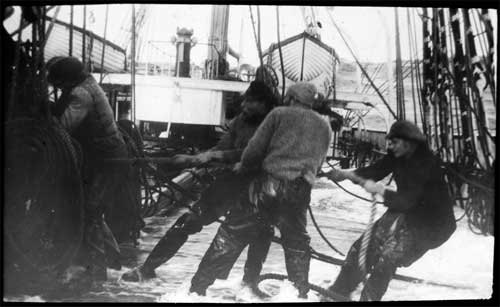Following the Wind: Seafarers Under Sail
The first mate was a kind of chief executive officer to the master. Except when all hands were on deck, the master would issue his orders through the mate, and it was the mate's responsibility to see them carried out. The second mate's primary duties were to "keep watch on the bridge, superintend the work of the ship in port under the chief officer, help the crew with the bos'un's assistance, and occasionally tally the cargo." (Committee on Manning, 158). In fact, all orders for the general maintenance of the ship were made by the first mate and were passed down to the seamen by the second mate. But in the routine working of the ship, such as setting or taking in sail, the crew followed the skipper's orders.
Beneath the officers, there was the bos'un (boatswain), the carpenter, the sailmaker and the cook, each of whom had very specific responsibilities. The bos'un, a petty officer, maintained the rigging and sails and supervised the crew in carrying out the officers' orders. The carpenter was a specialist, but he was likely skilled in more trades than his counterpart on shore. He was a blacksmith, a block and spar maker, a joiner, a boat-builder and a caulker (Bullen, 161). Able seamen were well-versed in the language and skills of seafaring. Ordinary seamen were young men yet to acquire significant experience and a period of three to four years might intervene before they were employed as "Able-bodied" Seamen. Seamen did the majority of the work, including steering by compass, splicing rope and working with the sails and rigging. Other duties were more general in nature: scrubbing the deck, chipping rust or working the capstan.

